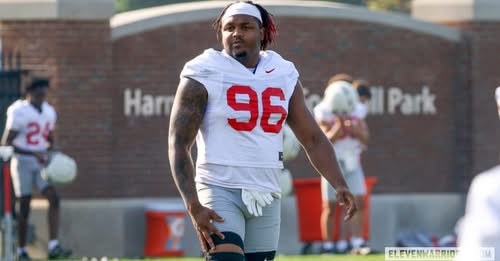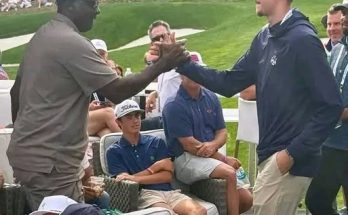Eddrick Houston’s return to full participation in practice this week brings a surge of optimism to Ohio State’s defensive front, but the storyline around the Buckeyes’ interior line doesn’t begin and end with his recovery. While Houston’s presence will undoubtedly bolster the rotation and potentially anchor a position group that has battled inconsistency and injury concerns, head coach Ryan Day’s recent comments have made it clear that the mission extends beyond simply welcoming one standout player back into the fold. Day is seeking not just competent depth, but multiple starting-caliber defensive tackles who can consistently disrupt the line of scrimmage, control the run game, and collapse the pocket from the inside out. It’s a goal that reflects both the heightened stakes of the Buckeyes’ season and the demanding standards the program has set for itself under his leadership.
Houston’s journey back to full contact drills has been closely monitored by the coaching staff. Regarded as one of the more physically gifted linemen on the roster, he has the size, length, and burst to influence plays in both phases of the game. Before his setback, he had been carving out a role that would have made him an every-down presence. His ability to shed blocks quickly and chase down plays laterally had stood out during early camp sessions, drawing praise from position coaches and teammates alike. Now, with his recovery process behind him, the expectation is that Houston can get back to that same level of dominance and help set the tone up front. Still, even with his return, Day knows that the demands of a grueling Big Ten schedule require more than one star to carry the load in the trenches.
The defensive tackle position in modern college football is one of the most physically taxing roles on the field. It’s not enough to have a singular force; teams must have a rotation that can keep legs fresh deep into the fourth quarter. Day has seen enough over the years to know that without two or three players who can legitimately start and perform at a high level, a defense can be worn down by power running attacks or quick-tempo offenses designed to neutralize a single threat. In Ohio State’s case, the search for more starting-caliber tackles is as much about strategy as it is about talent development. Depth doesn’t just mean having warm bodies—it means having interchangeable parts that can maintain or even elevate the standard when substitutions are made.
This reality is especially pressing when considering Ohio State’s championship aspirations. The path to a College Football Playoff berth will almost certainly involve matchups against some of the most potent offenses in the country, and the difference between a semifinal appearance and a national title often comes down to defensive line play. For Day, building an interior line that can dominate against both the run and the pass is a non-negotiable requirement. Even the most gifted edge rushers lose their effectiveness if the middle of the line caves in. That’s why, in recent practices, the emphasis has been on not just getting Houston back to speed, but also identifying who else can elevate their game enough to be trusted in the biggest moments.
The competition for those spots is ongoing. Several young players and reserves have shown flashes, but Day is looking for more than flashes—he’s looking for consistency, physical toughness, and mental sharpness. Practice habits have been scrutinized, as has each player’s ability to read and react to offensive schemes. In the Big Ten, where offenses can shift from smash-mouth power running one week to spread-tempo the next, a defensive tackle has to be as adept at anchoring against a double team as they are at stunting and chasing down a mobile quarterback. Day’s challenge is to foster an environment where those skill sets develop in unison.
Houston’s leadership in this process could prove invaluable. Players returning from injury often bring a heightened sense of urgency, and his teammates will be watching to see if he can recapture and perhaps even surpass his previous form. His presence in the meeting room and on the practice field could push others to meet the standard he sets. In a way, Houston’s return is about more than his individual contributions—it’s about raising the bar for everyone in the position group. Coaches have repeatedly stressed that leadership in the trenches is as much about showing by example as it is about vocal encouragement, and Houston is in a prime position to do both.
Ryan Day’s focus on this position group also speaks to a broader philosophy about how championship-level teams are built. While quarterbacks and skill position players often dominate headlines, championships are frequently decided in the less glamorous battles along the line of scrimmage. Day understands that an elite secondary is far more effective when the pass rush forces hurried throws, and that a linebacker corps can rack up tackles for loss only if the defensive line keeps blockers off the second level. By calling for more starting-caliber defensive tackles, Day is essentially calling for the foundation upon which the rest of the defense can thrive.
The challenge, of course, is that developing such players is not an overnight process. It requires a mix of recruiting the right talent, strength and conditioning programs that maximize athletic potential, and coaching that sharpens technique while instilling discipline. The physicality required to succeed at defensive tackle is immense, but so is the mental aspect. Gap integrity, leverage, hand placement, and recognition of blocking schemes are all areas where even physically gifted players can falter without the proper guidance and repetition. That’s why Day’s comments carry weight—they’re a reminder that raw ability alone won’t be enough to carry Ohio State to where it wants to go.
In addition to Houston, the Buckeyes have several candidates who could answer Day’s call. Each brings a different strength to the table—some are more explosive off the snap, others excel at clogging running lanes—but the goal will be to blend those individual strengths into a cohesive unit. The coaching staff will be watching closely in the coming weeks to see who can consistently win one-on-one matchups in practice, hold their ground against double teams, and create havoc in the backfield. It’s one thing to make a standout play; it’s another to repeat that performance series after series, game after game. That’s what separates a rotational piece from a true starter.
The timing of Houston’s return could be significant. As Ohio State ramps up its preparation for the start of the season, having him fully integrated into practice allows the staff to evaluate how he fits into different personnel groupings. It also provides a better gauge of how the other tackles respond to increased competition. Iron sharpens iron, and Day will be hoping that Houston’s presence pushes the entire group forward. There’s also the matter of building chemistry and communication among the front seven, something that can only be honed through repetition and live reps.
Day’s candid acknowledgment that more starting-caliber players need to emerge also sends a message to the team about accountability. At Ohio State, the standard is excellence across the board, and there’s no hiding in the depth chart. Every player knows that the opportunity is there, but so is the pressure to seize it. For some, this will be the moment that defines their college career—whether they can rise to meet the challenge or fade into the background. The head coach’s public challenge isn’t just a critique; it’s an invitation for players to step up and claim their role in what could be a special season.
The broader defensive strategy will also hinge on how this situation develops. If the Buckeyes can rotate three or four tackles who all play at a starting level, defensive coordinator Jim Knowles will have the flexibility to mix fronts, disguise blitzes, and keep offenses guessing. That versatility could be critical in games against high-powered offenses, where the ability to adjust on the fly can swing momentum. On the flip side, if the depth doesn’t materialize, the team may have to lean more heavily on certain players, increasing the risk of fatigue and injury as the season progresses.
For now, the storyline is one of cautious optimism. Houston’s return is an undeniable boost, and his impact could be felt immediately. But the real measure of Ohio State’s interior defensive line strength will come from the collective, not just the individual. Day’s challenge is to turn potential into production, and flashes into reliability. It’s a process that will play out over the coming practices and early-season games, but one that could very well determine whether this year’s Buckeyes reach the heights they’re aiming for.
In the end, Houston’s comeback and Day’s push for more starting-caliber defensive tackles are two sides of the same coin. One represents the return of proven talent, the other a call to action for those still looking to prove themselves. Together, they form the next chapter in Ohio State’s quest to build a defensive front capable of not just withstanding, but dictating the terms of battle in the trenches. And in a program where every season is measured by championships, meeting that challenge is not just important—it’s essential.



